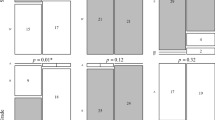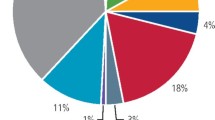Abstract
Objective
To evaluate the effectiveness of the simple flowcharts for practical periodontal diagnosis based on the 2018 new periodontal classification.
Materials and methods
In this randomized two-period crossover trial, 152 participants assigned a periodontal diagnosis for 25 case scenarios using the flowcharts (test group) and using the consensus reports (control group). Self-confidence questionnaires were completed at the end of each period. Questionnaires about the perception of the flowcharts were completed at the end of the study. The accuracy of the diagnosis, the time used, and participants’ confidence in assigning a diagnosis between using the flowcharts and using the consensus reports were compared.
Results
The mixed model analysis indicated that using the flowcharts was associated with a significant increase in the accuracy of the periodontal diagnosis, compared with using the consensus reports (P = 0.008). After the subgroup analysis, a significant increase in the accuracy of the full diagnosis and the accuracy of periodontal health, gingivitis, and periodontitis identification was seen in only the dental students. The time used for making the diagnosis using flowcharts and using consensus reports was similar. The self-confidence scores significantly increased when using flowcharts for diagnosis.
Conclusions
The simple flowcharts are user-friendly tools that can aid clinicians in accurately assigning a periodontal diagnosis and improve clinicians’ confidence in assigning a periodontal diagnosis using the new periodontal classification.
Clinical relevance
The flowcharts can be used for periodontal screening and assigning periodontal diagnosis using the new classification in routine practice.


Similar content being viewed by others
Data availability
Data are available on request from the authors.
References
Caton JG, Armitage G, Berglundh T, Chapple ILC, Jepsen S, Kornman KS, Mealey BL, Papapanou PN, Sanz M, Tonetti MS (2018) A new classification scheme for periodontal and peri-implant diseases and conditions - Introduction and key changes from the 1999 classification. J Periodontol 89(Suppl 1):S1–S8. https://doi.org/10.1002/JPER.18-0157
Armitage GC (1999) Development of a classification system for periodontal diseases and conditions. Ann Periodontol 4:1–6. https://doi.org/10.1902/annals.1999.4.1.1
Chapple ILC, Mealey BL, Van Dyke TE, Bartold PM, Dommisch H, Eickholz P, Geisinger ML, Genco RJ, Glogauer M, Goldstein M, Griffin TJ, Holmstrup P, Johnson GK, Kapila Y, Lang NP, Meyle J, Murakami S, Plemons J, Romito GA, Shapira L, Tatakis DN, Teughels W, Trombelli L, Walter C, Wimmer G, Xenoudi P, Yoshie H (2018) Periodontal health and gingival diseases and conditions on an intact and a reduced periodontium: Consensus report of workgroup 1 of the 2017 World Workshop on the Classification of Periodontal and Peri-Implant Diseases and Conditions. J Clin Periodontol 45(Suppl 20):S68–S77. https://doi.org/10.1111/jcpe.12940
Papapanou PN, Sanz M, Buduneli N, Dietrich T, Feres M, Fine DH, Flemmig TF, Garcia R, Giannobile WV, Graziani F, Greenwell H, Herrera D, Kao RT, Kebschull M, Kinane DF, Kirkwood KL, Kocher T, Kornman KS, Kumar PS, Loos BG, Machtei E, Meng H, Mombelli A, Needleman I, Offenbacher S, Seymour GJ, Teles R, Tonetti MS (2018) Periodontitis: Consensus report of workgroup 2 of the 2017 World Workshop on the Classification of Periodontal and Peri-Implant Diseases and Conditions. J Periodontol 89(Suppl 1):S173–S182. https://doi.org/10.1002/JPER.17-0721
The British Society of Periodontology (2018) Implementing the 2017 Classification of Periodontal Diseases to Reach a Diagnosis in Clinical Practice. BSP publishing bsperio. https://www.bsperio.org.uk/assets/downloads/111_153050_bsp-flowchart-implementing-the-2017-classification.pdf. Accessed 8 Aug 2022
Tonetti MS, Sanz M (2019) Implementation of the new classification of periodontal diseases: Decision-making algorithms for clinical practice and education. J Clin Periodontol 46:398–405. https://doi.org/10.1111/jcpe.13104
Sutthiboonyapan P, Wang HL, Charatkulangkun O (2020) Flowcharts for Easy Periodontal Diagnosis Based on the 2018 New Periodontal Classification. Clin Adv Periodontics 10:155–160. https://doi.org/10.1002/cap.10095
Chapin JR, Coleman G, Varner E (2011) Yes we can! Improving medical screening for intimate partner violence through self-efficacy. J Inj Violence Res 3:19–23. https://doi.org/10.5249/jivr.v3i1.62
Lyons BP, Dunson-Strane T, Sherman FT (2014) The joys of caring for older adults: training practitioners to empower older adults. J Community Health 39:464–470. https://doi.org/10.1007/s10900-013-9779-5
Turner KM, Nicholson JM, Sanders MR (2011) The role of practitioner self-efficacy, training, program and workplace factors on the implementation of an evidence-based parenting intervention in primary care. J Prim Prev 32:95–112. https://doi.org/10.1007/s10935-011-0240-1
Huser V, Narus SP, Rocha RA (2010) Evaluation of a flowchart-based EHR query system: a case study of RetroGuide. J Biomed Inform 43:41–50. https://doi.org/10.1016/j.jbi.2009.06.001
Stevens R, Bartlett H, Cooke R (2017) Evaluation of a clinical decision-making aid for nutrition advice in age-related macular degeneration. Br J Vis Impair 35:185–196. https://doi.org/10.1177/0264619616683989
Buntine P, Thien F, Stewart J, Woo YP, Koolstra M, Bridgford L, Datta M, Gwini SM (2019) Effect of a clinical flowchart incorporating Wells score, PERC rule and age-adjusted D-dimer on pulmonary embolism diagnosis, scan rates and diagnostic yield. Emerg Med Australas 31:216–224. https://doi.org/10.1111/1742-6723.13125
Acknowledgements
The authors offer special thanks to Assistant Professor Sanutm Mongkornkarn, Assistant Professor Dr. Supreda Srithanyarat, Assistant Professor Kanoknadda Tavedhikul and Dr. Nisachon Siripaiboonpong for participating in this study as the expert panel. Moreover, we thank Dr. Kevin Tompkins for language revision of the manuscript.
Funding
This study was supported by the Dental Research Fund, Faculty of Dentistry, Chulalongkorn University.
Author information
Authors and Affiliations
Contributions
S.P., O.C., A.L., and P.S. contributed to the conception and design of the study, acquisition of the data, and drafting of the article.
H.L.W. contributed to the conception and design of the study, critical revision of the article, and final approval of the version to be published.
Corresponding author
Ethics declarations
Ethics approval
Ethical approval (study code: HREC-DCU 2020–065) was obtained from the Human Research Ethics Committee at the Faculty of Dentistry, Chulalongkorn University.
Consent to participants
All subjects signed an inform consent before enrollment in the experiment.
Conflict of interest
The authors declare that they have no conflicts of interest related to this study.
Additional information
Publisher's note
Springer Nature remains neutral with regard to jurisdictional claims in published maps and institutional affiliations.
Supplementary Information
Below is the link to the electronic supplementary material.
784_2022_4662_MOESM1_ESM.pdf
Supplementary file1 Fig. S1 The self-confidence assessment for assigning a periodontal diagnosis based on the 2018 new periodontal classification (PDF 2687 KB)
784_2022_4662_MOESM2_ESM.pdf
Supplementary file2 Fig. S2 The perception assessment regarding the use of the flowcharts for assigning a periodontal diagnosis based on the 2018 new periodontal classification (PDF 2053 KB)
Rights and permissions
Springer Nature or its licensor holds exclusive rights to this article under a publishing agreement with the author(s) or other rightsholder(s); author self-archiving of the accepted manuscript version of this article is solely governed by the terms of such publishing agreement and applicable law.
About this article
Cite this article
Pakdeesettakul, S., Charatkulangkun, O., Lertpimonchai, A. et al. Simple flowcharts for periodontal diagnosis based on the 2018 new periodontal classification increased accuracy and clinician confidence in making a periodontal diagnosis: a randomized crossover trial. Clin Oral Invest 26, 7021–7031 (2022). https://doi.org/10.1007/s00784-022-04662-z
Received:
Accepted:
Published:
Issue Date:
DOI: https://doi.org/10.1007/s00784-022-04662-z




